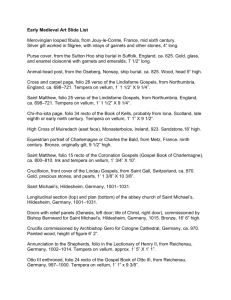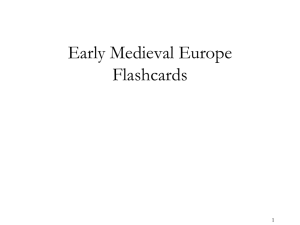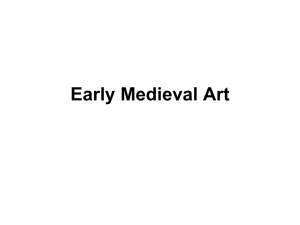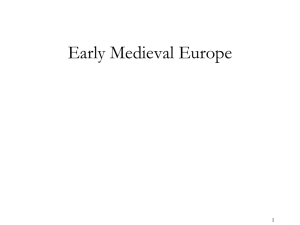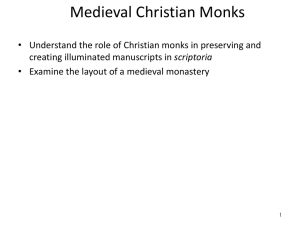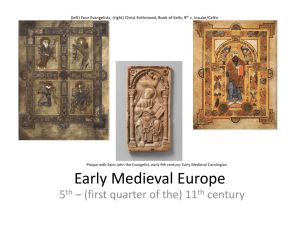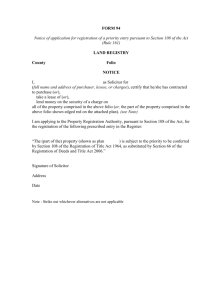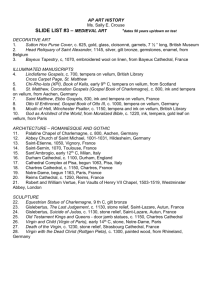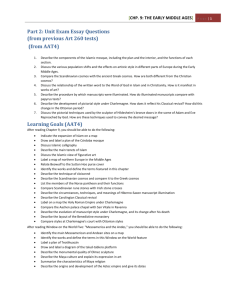Early Medieval
advertisement
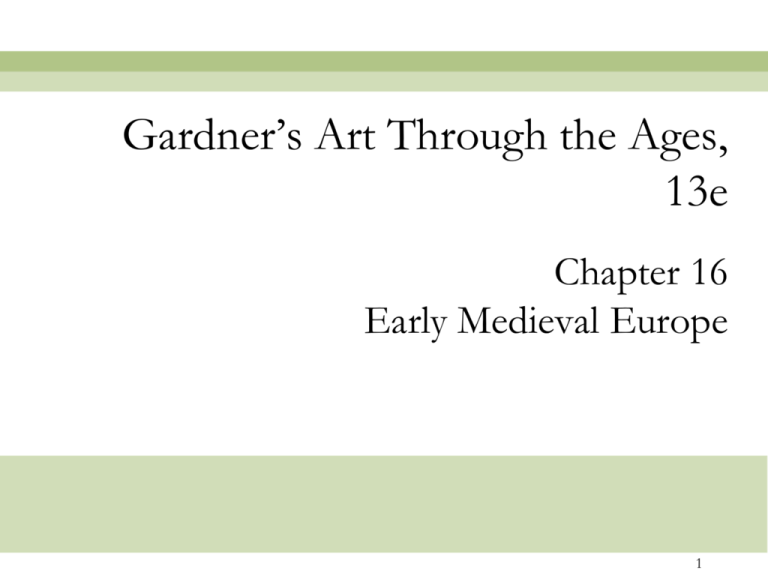
Gardner’s Art Through the Ages, 13e Chapter 16 Early Medieval Europe 1 Early Medieval Sites in Europe 2 Goals • Understand the distinctive artistic traditions of the European peoples after the fall of the Roman Empire. • Understand the chronological placement of this period following the fall of the western Roman Empire in the fourth century but preceding the Romanesque period of the 11th century. • Know the different types of art, media, and their respective cultures. • Appreciate the role of Christian monks in preserving and creating art • Trace influences of medieval art styles. • Examine the secular and religious architectural forms in the early Middle Ages. 3 Northern European Art • Understand the artistic, technical and stylistic traditions of the northern European peoples. • Know the different types of art and the respective cultures associated with the Merovingians, Anglo-Saxons, and Vikings. • Examine the artistic traditions applied to a variety of media, such as wood, stone, and metal. 4 Merovingian and Saxon Art • Understand the artistic, technical and stylistic traditions. • Know the different types of art and the respective cultures associated with the Merovingians and Saxons. 5 Figure 16-2 Pair of Merovingian looped fibulae, from Jouy-le-Comte, France, mid-sixth century. Silver gilt worked in filigree, with inlays of garnets and other stones, 4” high. Musée d’Archéologie nationale, Saint-Germain-en-Laye. 6 Figure 16-3 Purse cover, from the Sutton Hoo ship burial in Suffolk, England, ca. 625. Gold, glass, and cloisonné garnets, 7 1/2” long. British Museum, London. 7 16-3A Belt buckle, from the Sutton Hoo ship burial in Suffolk, England, ca. 625. Gold, 5 1/4" long. British Museum, London. 8 Interlaced Animal Style • Examine the European artistic traditions applied to a variety of media, such as wood, stone, and metal. • Notice the imagery includes intertwined ribbon-like designs called interlacing as well as abstract animal imagery. These design features reflect the cultures of pre-Christian Northern Europe. 9 Figure 16-4 Animal-head post, from the Viking ship burial, Oseberg, Norway, ca. 825. Wood, head 5” high. University Museum of National Antiquities, Oslo. 10 16-4A Viking ship burial, Oseberg, Norway, ca. 815–820. Wood, 70’ 10 3/8" long. Viking Ship Museum, University of Oslo, Bygdoy. 11 Figure 16-5 Wooden portal of the stave church at Urnes, Norway, ca. 1050–1070. 12 Hiberno-Saxon Art (6th to 10th centuries) • Understand the Saxon artistic influence in the British Isles. • Understand the early influence of Christianity and the ways in which indigenous art forms serve the cause of Christianity. • Describe the specific art elements and principles of design applied to the illuminated manuscripts, Celtic crosses and other objects. • Observe the continuation of interlacing and abstract animal imagery. Why did art used for Christian purposes retain these qualities? 13 Figure 16-6 Man (symbol of Saint Matthew), folio 21 verso of the Book of Durrow, possibly from Iona, Scotland, ca. 660–680. Ink and tempera on parchment, 9 5/8” X 6 1/8”. Trinity College Library, Dublin. 14 Figure 16-1 Cross-inscribed carpet page, folio 26 verso of the Lindisfarne Gospels, from Northumbria, England, ca. 698–721. Tempera on vellum, 1’ 1 1/2” X 9 1/4”. British Library, London. 15 Figure 16-7 Saint Matthew, folio 25 verso of the Lindisfarne Gospels, from Northumbria, England, ca. 698–721. Tempera on vellum, 1’ 1 1/2” X 9 1/4”. British Library, London. 16 Figure 16-8 Chi-rho-iota (XPI) page, folio 34 recto of the Book of Kells, probably from Iona, Scotland, late eighth or early ninth century. Tempera on vellum, 1’ 1” X 9 1/2”. Trinity College Library, Dublin. 17 Medieval Christian Monks • Understand the role of Christian monks in preserving and creating illuminated manuscripts in scriptoria • Examine the layout of a medieval monastery 18 Figure 16-19 Schematic plan for a monastery at Saint Gall, Switzerland, ca. 819. Red ink on parchment, 2’ 4” X 3’ 8 1/8”. Stiftsbibliothek, Saint Gall. 19 16-19A Abbey of Saint-Riquier, Centula, France, 790– 799, in an engraving of 1612 after a lost 11th-century manuscript illumination. Bibliothèque Nationale, Paris. 20 Celtic Crosses • Describe the specific art elements and principles of design applied to the Celtic crosses. 21 Figure 16-9 High Cross of Muiredach (east face), Monasterboice, Ireland, 923. Sandstone, 18’ high. 22 16-9A South Cross, Ahenny, Ireland, late 8th century. Sandstone, 12’ 9 1/2" high. 23 16-10 San Juan Bautista, Banos de Cerrato, Spain, 661. 24 16-11 Emeritus, the tower and scriptorium of San Salvador de Tabara, colophon (folio 168) of the Commentary on the Apocalypse by Beatus, from Tabara, Spain, 970. Tempera on parchment, 1’ 2 1/8” X 10”. Archivo Historico Nacional, Madrid. 25 Carolingian Art (9th century – present day France and Germany) • Understand the political and religious influences on art and architecture during the Carolingian period. • Understand the ‘revival of learning’ and the art of the book as a result of Charlemagne’s interests. • Examine the secular and religious architectural forms in the Carolingian period. 26 Figure 16-12 Equestrian portrait of Charlemagne or Charles the Bald, from Metz, France, ninth century. Bronze, originally gilt, 9 1/2” high. Louvre, Paris. 27 The Carolingian Renovation • Observe how Charlemagne’s empire revived Roman art and architectural forms. Why did he desire to do this? • Understand the ‘revival of learning’ and the art of the book. 28 Figure 16-13 Saint Matthew, folio 15 recto of the Coronation Gospels (Gospel Book of Charlemagne), from Aachen, Germany, ca. 800– 810. Ink and tempera on vellum, 1’ 3/4” X 10”. Schatzkammer, Kunsthistorisches Museum, Vienna. 29 16-13A Christ enthroned, folio 3 recto of the Godescalc Lectionary, 781–783. Ink, gold, and colors on vellum, 1’ 5/8” X 8 1/4". Bibliothèque Nationale, Paris. 30 Figure 16-14 Saint Matthew, folio 18 verso of the Ebbo Gospels (Gospel Book of Archbishop Ebbo of Reims), from Hautvillers (near Reims), France, ca. 816–835. Ink and tempera on vellum, 10 1/4” X 8 3/4”. Bibliothèque Municipale, Épernay. 31 16-15 Psalm 44, detail of folio 25 recto of the Utrecht Psalter, from Hautvillers (near Reims), France, ca. 820835. Ink on vellum, full page, 1’ 1” X 9 7/8”;detail, 4 ½” high. University Library, Utrecht. 32 16-15A Psalm 23, folio 13 recto of the Utrecht Psalter, from Hautvillers (near Reims), France, ca. 820–835. Ink on vellum, 1’ 1" X 9 7/8". University Library, Utrecht. 33 Art of Charlemagne’s Court • Examine the gold and jeweled secular and religious court art under Charlemagne and his successors. 34 Figure 16-16 Crucifixion, front cover of the Lindau Gospels, from Saint Gall, Switzerland, ca. 870. Gold, precious stones, and pearls, 1’ 1 3/8” X 10 3/8”. Pierpont Morgan Library, New York. 35 Carolingian Architecture • Examine the secular and religious architectural forms in the Carolingian period. 36 Figure 16-17 Restored plan of the Palatine Chapel of Charlemagne, Aachen, Germany, 792-805. 37 Figure 16-18 Interior of the Palatine Chapel of Charlemagne, Aachen, Germany, 792–805. 38 Figure 16-20 Westwork of the abbey church, Corvey, Germany, 873–885. 39 16-20A Torhalle, Lorsch, Germany, late eighth or ninth century. 40 Ottonian Art (10th century Germany) • Examine the architecture associated with the Ottonians, its formal origins and its later influence. • Understand the architectural and free standing sculptural traditions of the Ottonians. • Compare and contrast Ottonian and Carolingian art • Examine the styles of the Ottonian illuminated manuscripts. 41 Architecture of the Ottonians • Examine the architecture, its formal origins and its later influence. 42 Figure 16-21 Nave of the church of Saint Cyriakus, Gernrode, Germany, 961–973. 43 Figure 16-22 Saint Michael’s, Hildesheim, Germany, 1001–1031. 44 Figure 16-23 Longitudinal section (top) and plan (bottom) of the abbey church of Saint Michael’s, Hildesheim, Germany, 1001–1031. 45 16-23A Nave (looking east) of Saint Michael’s, Hildesheim, 1001–1031. 46 Ottonian Sculpture • Understand the architectural sculpture associated with St. Michael’s at Hildesheim, Germany. • Examine the free standing sculptural traditions of the Ottonians. 47 Figure 16-24 Doors with relief panels (Genesis, left door; life of Christ, right door), commissioned by Bishop Bernward for Saint Michael’s, Hildesheim, Germany, 1015. Bronze, 16’ 6” high. DomMuseum, Hildesheim. 48 16-24A Otto I presenting Magdeburg Cathedral to Christ, from Magdeburg Cathedral, Magdeburg, Germany, 962–968. Ivory, 5” X 4 1/2". Metropolitan Museum of Art, New York (gift of George Blumenthal, 1941). 49 Figure 16-25 Column with reliefs illustrating the life of Christ, commissioned by Bishop Bernward for Saint Michael’s, Hildesheim, Germany, ca. 1015–1022. Bronze, 12’ 6” tall. Dom-Museum, Hildesheim. 50 Figure 16-26 Crucifix commissioned by Archbishop Gero for Cologne Cathedral, Germany, ca. 970. Painted wood, height of figure 6’ 2”. Cathedral, Cologne. 51 16-27 Abbess Uta dedicating her codex to the Virgin, folio 2 recto of the Uta Codex, from Regensburg, Germany, ca. 1025. Tempera on parchment, 9 5/8” X 5 1/8”. Bayerische Staatsbibliothek, Munich. 52 Ottonian Illuminated Manuscripts • Examine the appearance of the Ottonian illuminated manuscripts. • Notice the golden backgrounds and linear figural styles in Ottonian illuminated manuscripts --- Ottonian leaders developed significant contacts with the Byzantine empire. 53 Figure 16-28 Annunciation to the Shepherds, folio in the Lectionary of Henry II, from Reichenau, Germany, 1002–1014. Tempera on vellum, approx. 1’ 5” X 1’ 1”. Bayerische Staatsbibliothek, Munich. 54 16-28A Christ blessing Otto II and Theophanu, 972–973. Ivory, 7 1/8” X 4”. Musée National du Moyen Age, Paris. 55 Figure 16-29 Otto III enthroned, folio 24 recto of the Gospel Book of Otto III, from Reichenau, Germany, 997–1000. Tempera on vellum, 1’ 1” x 9 3/8”. Bayerische Staatsbibliothek, Munich. 56 16-29A Jesus washing the feet of Saint Peter, folio 237 recto of the Gospel Book of Otto III, 997–1000. Tempera on vellum, 1’ 1” X 9 3/8”. Bayerische Staatsbibliothek, Munich. 57 Discussion Questions In what ways did medieval European art and architecture depart from classical Roman art and architecture? Did any of the civilizations retain characteristics of Roman art and architecture? Explain. Compare the three major manuscript styles that developed in the Middle Ages. What previous styles of art influenced medieval European art? 58
